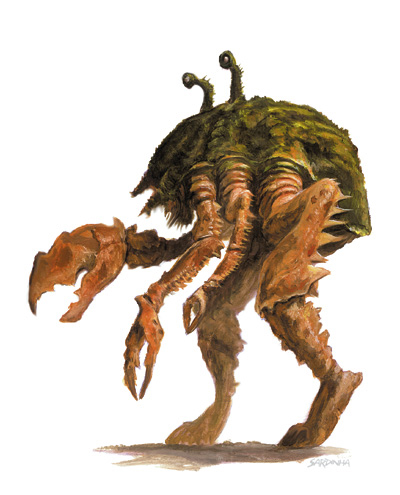
Species Name: Carapace, Crab men
Type: Humanoid Crab
Physical Traits: Carapace walk upright on two pairs of legs. The small pincers tipping the short arms above their legs are used for fine manipulation. The two longer arms end in large claws. Two slender eyestalks bob above the beak-like collection of mandibles which makes up their mouth. Males are often brightly coloured and females may be reddish-brown, green, or black.
Height: 7-9 feet
Weight: 50-100lbs
Abilities: Carapace can dive down to a maximum depth of 20 metres per CON and can see in low light with absolute clarity at a distance of 60 feet. Though generally peaceful, Carapace will fight back with their large claws if attacked, causing D6 points of damage per hit. Males of certain subspecies have an enlarged claw on one side which does D8 damage. If severed, a Carapace’s limbs and eyestalks will grow back in 1-4 weeks.
Mobility: Legs
Sensory Organs: Visual
Communication: Visual
Reproduction:
Carapace have no regular breeding or mating cycle, and each female
seems to have her own periods of fertility and infertility. A fertile female
will produce about 100 eggs within a two-week period. Carapace eggs are released
into the ocean, hatching into translucent larvae with soft shells. These larvae
vaguely resemble the adults, but may be mistaken for normal crabs given their
size. After 6 months, Carapace larvae molt and develop the harder shell required
for life on land. Before their first molting, Carapace larvae are practically
defenseless. Larvae are almost defenseless, with AC 8, 1 HD, and weak claws which do only 1-2 points of
damage per hit.
Carapace continue to grow and molt throughout their lives.
INT: 3D6, WIS: 3D6, STR: 3D6 +5, DEX: 3D6, CON: 3D6 +4, CHA: 3D6 -3, MR: 2D6 walk/2D6 swim, HPs: CON +D20, AC: 2
Orbit/Climate: See Earth
Feeding Habits: Carapace inhabit coastal waters, hunting fish and gathering food.
Lifespan: 20 years
Technology: 2
Culture: Hostile, intolerant and aggressive, held in check by strong social customs. Carapace have never been known to wield weapons. At certain times, population pressure and food shortages will cause Carapace to voraciously hunt other creatures. Most such attacks are directed towards other tribes of Carapace or other coastal inhabitants. However, they will occasionally raid coastal towns for food, attacking anything that moves. Such savage frenzies last only a few days, during which the Carapace population is generally reduced back to a tolerable level. Carapace live as simple hunter-gatherers, subsisting primarily on carrion and algae. Much of each Carapace’s day is spent hunting, filtering algae, or scavenging along the shore. Carapace often gather large amounts of sand into their mouths, suck out all the organic material, and spit out fist-sized pellets of sand and dirt. These hardened pellets betray the presence of a nearby Carapace lair. Carapace generally live in coastal caves. Some tribes dig extensive burrows in seaside cliffs. Within a burrow complex, each Carapace has an individual lair, situated near a large, central meeting area. Males and females are found in approximately equal numbers in a tribe. They mate at irregular times throughout the year. The female produces about 100 eggs within two weeks. They are laid in the ocean, where they hatch into clear, soft-shelled, crablike larvae. In six months they molt, develop a stronger shell, and begin to dwell on land. The eggs and larvae are delicious, and predators greatly reduce their numbers before they reach adulthood. A Carapace tribe seldom has commerce with other tribes, and almost never with other intelligent races. They produce few artifacts, primarily seaweed weavings, driftwood carvings, and seashell constructions. Though these are often impermanent, some are quite beautiful. Though details of Carapace religion are unknown, most artifacts are believed to be religious in nature, and are jealously guarded. Each tribe appears to be led by a dominant, elder male or female. These leaders have maximum hit points, but are otherwise unremarkable.
Carapace speak their own language, which consists mostly of hisses and clicks. The Carapace’s xenophobia and the extreme difficulty of their language make it virtually impossible for humans and similar races to learn to speak the Carapace tongue. Those few sages who know anything about the language know only a few basic words. They are attracted to shiny metal, particularly silver-coloured metal, though they seem unable to differentiate between silver, platinum, and steel. Carapace lairs often contain piles of these metals, with many pieces worked into sculptures. If the metal has rusted or tarnished, it is sometimes scraped to reveal the shine again, but often simply thrown into a refuse pile. Carapace artifacts can sometimes bring good prices from collectors, though they are often fragile, and readily decompose if made of plants. Carapace are rumoured to be very tasty, especially their legs and claws. Primitive coastal inhabitants, particularly Sahuagin, consider them a delicacy and often raid Carapace villages. Their shells dry out and become brittle soon after they are removed or molted, so they cannot be used as armour. The claws can be used as passable clubs. Carapace rarely engage in commerce with other humanoid communities around them, including other Carapace tribes. Carapace artisans produce only ephemeral goods made of driftwood, shells, and seaweed, and are quite capable of producing what other more aesthetic races would call works of art.
Government: Tribal
Population: 5,666,620